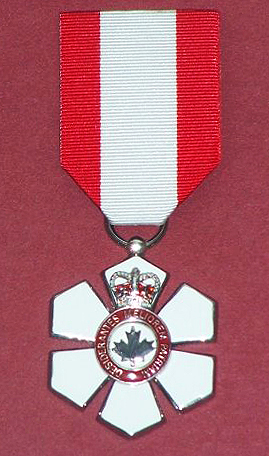
The Order of Canada is a Canadian state order and the second-highest honour for merit in the system of orders, decorations, and medals of Canada, after the Order of Merit.

The Order of Ontario is the most prestigious official honour in the Canadian province of Ontario. Instituted in 1986 by Lieutenant Governor Lincoln Alexander, on the advice of the Cabinet under Premier David Peterson, the civilian order is administered by the Lieutenant Governor-in-Council and is intended to honour current or former Ontario residents for conspicuous achievements in any field.

The Royal Victorian Order is a dynastic order of knighthood established in 1896 by Queen Victoria. It recognises distinguished personal service to the British monarch, Canadian monarch, Australian monarch, or New Zealand monarch, members of the monarch's family, or to any viceroy or senior representative of the monarch. The present monarch, King Charles III, is the sovereign of the order. The order's motto is Victoria. The order's official day is 20 June. The order's chapel is the Savoy Chapel in London.

The Order of British Columbia is a civilian honour for merit in the Canadian province of British Columbia. Instituted in 1989 by Lieutenant Governor David Lam, on the advice of the Cabinet under Premier Bill Vander Zalm, the order is administered by the Governor-in-Council and is intended to honour current or former British Columbia residents for conspicuous achievements in any field, being thus described as the highest honour amongst all others conferred by the British Columbia Crown.
The Saskatchewan Order of Merit is a civilian honour for merit in the Canadian province of Saskatchewan. Instituted in 1985 by Lieutenant Governor Frederick Johnson, on the advice of the Cabinet under Premier Grant Devine, the order is administered by the Governor-in-Council and is intended to honour current or former Saskatchewan residents for conspicuous achievements in any field, being thus described in law as the highest honour amongst all others conferred by the Saskatchewan Crown. The Saskatchewan Order of Merit has been criticized for not fairly considering researchers in engineering, computer science, mathematics, physics, and geology.
The Order of New Brunswick is a civilian honour for merit in the Canadian province of New Brunswick. Instituted in 2000 by Lieutenant Governor Marilyn Trenholme Counsell, on the advice of the Cabinet under Premier Bernard Lord, the order is administered by the Governor-in-Council and is intended to honour current or former New Brunswick residents for conspicuous achievements in any field, being thus described as the highest honour amongst all others conferred by the New Brunswick Crown.
The Order of Newfoundland and Labrador is a civilian honour for merit in the Canadian province of Newfoundland and Labrador. Instituted in 2001, when Lieutenant Governor Arthur Maxwell House granted Royal Assent to the Order of Newfoundland and Labrador Act, the order is administered by the Governor-in-Council and is intended to honour current or former Newfoundland and Labrador residents for conspicuous achievements in any field, being thus described as the highest honour amongst all others conferred by the Newfoundland and Labrador Crown.
The Order of Prince Edward Island is a civilian honour for merit in the Canadian province of Prince Edward Island. Instituted in 1996 by Lieutenant Governor Gilbert Clements, on the advice of the Cabinet under Premier Catherine Callbeck, the order is administered by the Governor-in-Council and is intended to honour current or former Prince Edward Island residents for conspicuous achievements in any field, being thus described as the highest honour amongst all others conferred by the Prince Edward Island Crown.
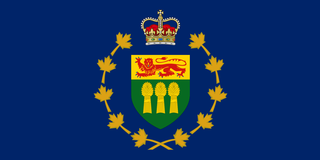
The lieutenant governor of Saskatchewan is the viceregal representative in Saskatchewan of the Canadian monarch, King Charles III, who operates distinctly within the province but is also shared equally with the ten other jurisdictions of Canada, as well as the other Commonwealth realms and any subdivisions thereof, and resides predominantly in his oldest realm, the United Kingdom. The lieutenant governor of Saskatchewan is appointed in the same manner as the other provincial viceroys in Canada and is similarly tasked with carrying out most of the monarch's constitutional and ceremonial duties. The current lieutenant governor is Russell Mirasty, who was appointed on July 17, 2019, following the death in office of Lieutenant Governor W. Thomas Molloy, on July 2, 2019.
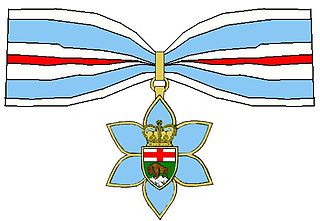
The Order of Manitoba is a civilian honour for merit in the Canadian province of Manitoba. Instituted in 1999 when Lieutenant Governor Peter Liba granted royal assent to the Order of Manitoba Act, the order is administered by the Governor-in-Council and is intended to honour current or former Manitoba residents for conspicuous achievements in any field, being thus described as the highest honour amongst all others conferred by the Manitoba Crown.

The Order of Nova Scotia is a civilian honour for merit in the Canadian province of Nova Scotia. Instituted on August 2, 2001, when Lieutenant Governor Myra Freeman granted Royal Assent to the Order of Nova Scotia Act, the order is administered by the Governor-in-Council and is intended to honour current or former Nova Scotia residents for conspicuous achievements in any field, being thus described as the highest honour amongst all others conferred by the Nova Scotia Crown.
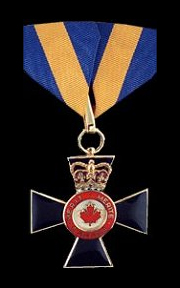
The Order of Merit of the Police Forces is an honour for merit that is, within the Canadian system of honours, the only such fellowship reserved for only members of Canada's various police forces. Created in 2000, the order is administered by the Governor in Council, on behalf of the Canadian monarch. Appointment to the order recognizes conspicuous merit and exceptional service, the level of which is reflected by the organization's three hierarchical grades.
The orders, decorations, and medals of Canada comprise a complex system by which Canadians are honoured by the country's sovereign for actions or deeds that benefit their community or the country at large. Modelled on its British predecessor, the structure originated in the 1930s, but began to come to full fruition at the time of Canada's centennial in 1967, with the establishment of the Order of Canada, and has since grown in both size and scope to include dynastic and national orders, state, civil, and military decorations; and various campaign medals. The monarch in right of each Canadian province also issues distinct orders and medals to honour residents for work performed in just their province. The provincial honours, as with some of their national counterparts, grant the use of post-nominal letters and or supporters and other devices to be used on personal coats of arms.
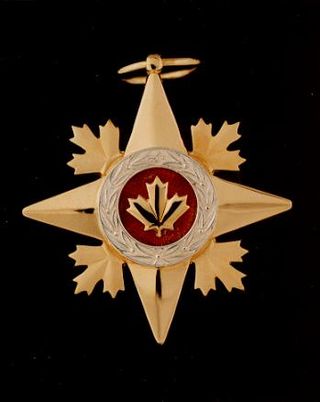
The Star of Military Valour is a military decoration that is, within the Canadian system of honours, the second highest award for military valour, and one of three honours for military valour awarded by the Canadian monarch, generally through his or her viceroy-in-Council. Created in 1993, the medal is presented to both living and deceased members of the Canadian Forces deemed to have demonstrated "distinguished and valiant service in the presence of the enemy," and grants recipients the ability to use the post-nominal letters SMV.

Canadian royal symbols are the visual and auditory identifiers of the Canadian monarchy, including the viceroys, in the country's federal and provincial jurisdictions. These may specifically distinguish organizations that derive their authority from the Crown, establishments with royal associations, or merely be ways of expressing loyal or patriotic sentiment.

By the arrangements of the Canadian federation, Canada's monarchy operates in Alberta as the core of the province's Westminster-style parliamentary democracy. As such, the Crown within Alberta's jurisdiction is referred to as the Crown in Right of Alberta, His Majesty in Right of Alberta, or The King in Right of Alberta. The Constitution Act, 1867, however, leaves many royal duties in Alberta specifically assigned to the sovereign's viceroy, the Lieutenant Governor of Alberta, whose direct participation in governance is limited by the conventional stipulations of constitutional monarchy.

The monarchy of Canada forms the core of each Canadian provincial jurisdiction's Westminster-style parliamentary democracy, being the foundation of the executive, legislative, and judicial branches of government in each province. The monarchy has been headed since September 8, 2022 by King Charles III who as sovereign is shared equally with both the Commonwealth realms and the Canadian federal entity. He, his consort, and other members of the Canadian royal family undertake various public and private functions across the country. He is the only member of the royal family with any constitutional role.
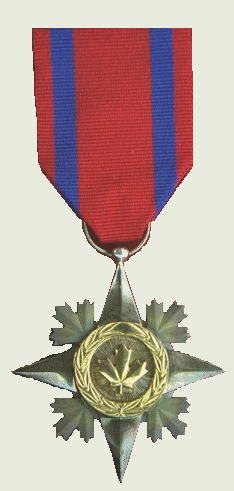
The Star of Courage is a decoration that is the second-highest award for bravery within the Canadian system of honours, and one of the three Canadian Bravery Decorations awarded by the Canadian monarch, generally through his or her viceroy-in-Council. Created in 1972, it is presented to both living and deceased individuals deemed to have performed "acts of conspicuous courage in circumstances of great peril". Recipients are allowed to use post-nominal letters – for Anglophones SC, and for Francophones ÉC.

The Order of Military Merit is a military honour for merit that is, within the Canadian system of honours, the second highest order administered by the governor in Council on behalf of the Canadian monarch.













